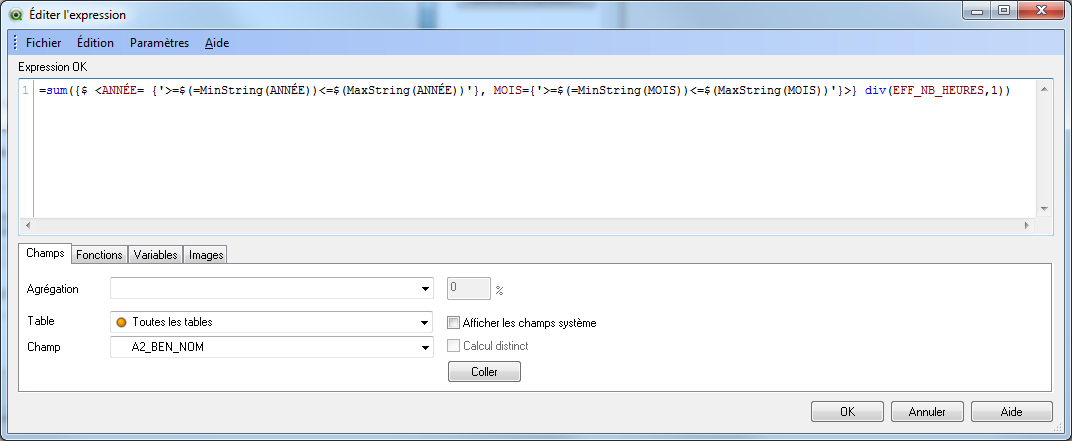Unlock a world of possibilities! Login now and discover the exclusive benefits awaiting you.
- Qlik Community
- :
- All Forums
- :
- QlikView App Dev
- :
- Re: Aggrégation somme et variables dynamiques
- Subscribe to RSS Feed
- Mark Topic as New
- Mark Topic as Read
- Float this Topic for Current User
- Bookmark
- Subscribe
- Mute
- Printer Friendly Page
- Mark as New
- Bookmark
- Subscribe
- Mute
- Subscribe to RSS Feed
- Permalink
- Report Inappropriate Content
Aggrégation somme et variables dynamiques
Bonjour à tous,
Voici une petite formule avec des valeurs « en dur » :
=sum({$ <ANNÉE= {2012,2013}, MOIS={août, sept., oct.}>} div(EFF_NB_HEURES,1))
Je souhaite remplacer 2012, 2013 par MinString(ANNÉE) et MaxString(ANNÉE), ainsi que août, sept., oct. par MinString (MOIS) MaxString(MOIS) car ce sont des critères de sélection pour mes calculs.
Mais ça ne marche pas, c'est une syntaxe qui ne semble pas plaire à QlikView…
Avez-vous une idée ? Merci d'avance.
- « Previous Replies
-
- 1
- 2
- Next Replies »
Accepted Solutions
- Mark as New
- Bookmark
- Subscribe
- Mute
- Subscribe to RSS Feed
- Permalink
- Report Inappropriate Content
I wrote something not bad :
=Round((((sum({$<DATE_ANNEE = {$(#=NumMax(Num#(MinString(DATE_ANNEE)), Num#(MaxString(DATE_ANNEE))))}>} EFF_NB_HEURES)/8)-(sum({$<DATE_ANNEE = {$(#=NumMin(Num#(MinString(DATE_ANNEE)), Num#(MaxString(DATE_ANNEE))))}>} EFF_NB_HEURES)/8))/(sum({$<DATE_ANNEE = {$(#=NumMin(Num#(MinString(DATE_ANNEE)), Num#(MaxString(DATE_ANNEE))))}>} EFF_NB_HEURES)/8))*100,0.01)&' %'
I'm sure it could be shorter, but it works !
Thanks for all ![]()
- Mark as New
- Bookmark
- Subscribe
- Mute
- Subscribe to RSS Feed
- Permalink
- Report Inappropriate Content
=sum({$ <ANNÉE= {'>=$(=MinString(ANNÉE))<=$(MaxString(ANNÉE))'}, MOIS={'>=$(=MinString(MOIS))<=$(MaxString(MOIS))'}>} div(EFF_NB_HEURES,1))
- Mark as New
- Bookmark
- Subscribe
- Mute
- Subscribe to RSS Feed
- Permalink
- Report Inappropriate Content
Quelle réactivité, et quelle syntaxe !!!

Malheureusement, comme le montre la copie d'écran, cela n'a pas l'air de plaire à QV, la coloration syntaxique semble indiquer un je ne sais quoi qui va pas…
- Mark as New
- Bookmark
- Subscribe
- Mute
- Subscribe to RSS Feed
- Permalink
- Report Inappropriate Content
The syntax highlighting is correct. When you do calculations within set analysis, it doesn't highlight them like regular calculations.
- Mark as New
- Bookmark
- Subscribe
- Mute
- Subscribe to RSS Feed
- Permalink
- Report Inappropriate Content
The result is 0, it should be 491'446. The formula is in a text object, should it be somewhere else ?
- Mark as New
- Bookmark
- Subscribe
- Mute
- Subscribe to RSS Feed
- Permalink
- Report Inappropriate Content
Are your months just text fields or are they dual fields? If they're just text fields, it won't work (you'll need to change them to be duals).
- Mark as New
- Bookmark
- Subscribe
- Mute
- Subscribe to RSS Feed
- Permalink
- Report Inappropriate Content
Actually, I have a field with lots of SQL Timestamp. In the script I use this statement to extract month :
Month(EFF_DATE_FIN) as MOIS,
and in the table it appears
eff_date_fin année mois semaine
41103 2012 juil. 28
41138 2012 août 33
I'll see how to change them to be duals.
Thanks
Modified :
In the table viewer, MOIS is $numeric, $integer. I'm not sure statement dual is usefull, and it don't work.
LOAD Dual (string, numrep) as MOIS inline
[string, numrep
janv., 1
févr., 2
mars, 3
avr., 4
mai, 5
juin, 6
juil., 7
août, 8
sept., 9
oct., 10
nov., 11
déc., 12];
DATE:
LOAD EFF_DATE_FIN,
Year(EFF_DATE_FIN) as ANNÉE,
Month(EFF_DATE_FIN) as MOIS,
Week(EFF_DATE_FIN) as SEMAINE
FROM QVD\TACHE.qvd(qvd);
Where is my mistake ?
- Mark as New
- Bookmark
- Subscribe
- Mute
- Subscribe to RSS Feed
- Permalink
- Report Inappropriate Content
fong quentin wrote:
In the table viewer, MOIS is $numeric, $integer.
That's all that matters. Just needed to make sure the text field was in fact also being represented as a number.
Without having an actual .qvw file to look at, I don't believe I can help you any further. Can you create a sample file or upload one that is scrambled (Preparing examples for Upload - Reduction and Data Scrambling)? It would also help to know what you expect to get vs. what you're actually seeing.
- Mark as New
- Bookmark
- Subscribe
- Mute
- Subscribe to RSS Feed
- Permalink
- Report Inappropriate Content
Hope it will be helpfull,
Thanks !
- Mark as New
- Bookmark
- Subscribe
- Mute
- Subscribe to RSS Feed
- Permalink
- Report Inappropriate Content
Where are you trying to use the calculation on that dashboard? What is it returning and what do you think it should be returning?
- « Previous Replies
-
- 1
- 2
- Next Replies »